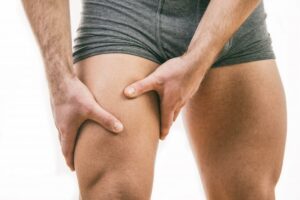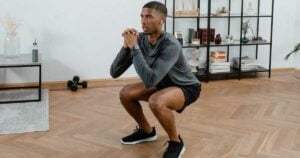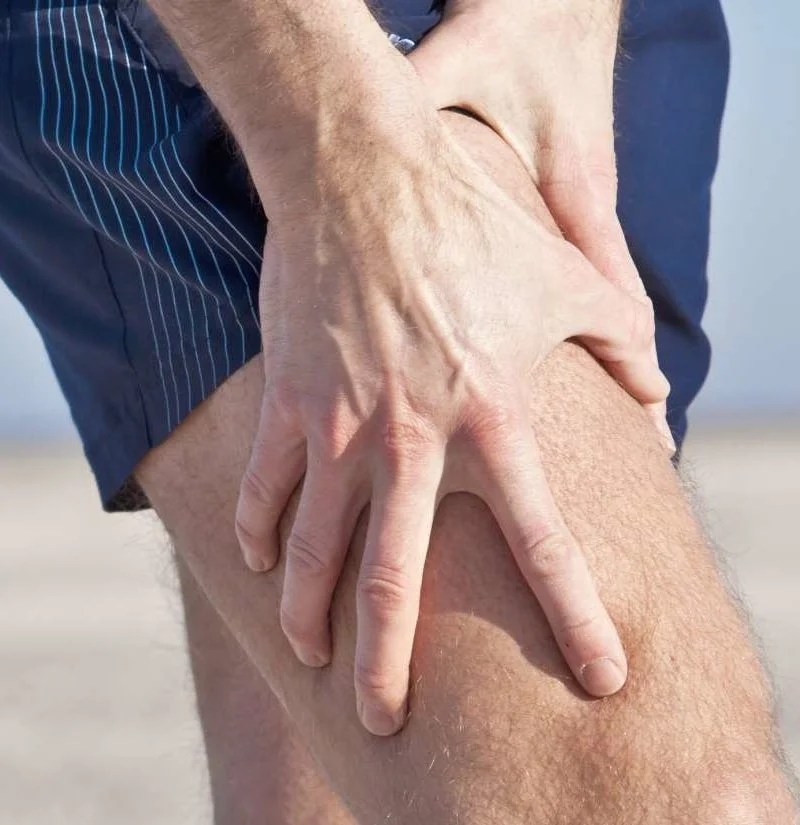In the hustle and bustle of our daily lives, our bodies often bear the brunt of our ceaseless activities, with the upper thigh joint being one area that can frequently be affected. Understanding the root causes of upper thigh joint pain and adopting strategies to alleviate it can pave the way to a smoother, pain-free existence. In this blog post, we will delve into the intricacies of upper thigh joint pain, offering insights and solutions that can help you reclaim your mobility and joy in life.
Contents
Why Does The Joint In My Upper Thigh Hurt?
 Pain in the upper thigh joint could arise from various factors. Here, we will outline several potential causes for upper thigh joint pain:
Pain in the upper thigh joint could arise from various factors. Here, we will outline several potential causes for upper thigh joint pain:
- Muscle Strain or Sprain
Overexertion, sudden movements, or an accident can strain or sprain the muscles surrounding the upper thigh joint, causing pain and discomfort.
- Hip Osteoarthritis
This is a condition characterized by the wear and tear of the hip joint. That can result in upper thigh pain due to the close proximity of the hip to the upper thigh region.
- Bursitis
Inflammation of the bursa, a small sac filled with fluid that helps to reduce friction in the joints, could be another cause. This condition can sometimes be experienced as pain in the upper thigh region.
This nerve-related issue can cause pain that radiates from the lower back through the hip and down the leg, including the upper thigh.
- Fractures or Injuries
Any fracture or injury in the hip joint or femur (thigh bone) can result in upper thigh pain.
- Meralgia Paresthetica
A condition characterized by tingling, numbness, and burning pain in the outer thigh, due to compression of the nerve that supplies sensation to the skin surface of the thigh.
- Iliotibial Band Syndrome (ITBS)
This is a common knee injury that can also cause pain in the upper thigh. As the iliotibial band runs from the hip to the knee.
- Blood Clots
In some cases, a blood clot in a vein in the upper thigh can cause pain and swelling in the area.
Remember, the above explanations are not exhaustive. It’s critical to consult with a healthcare provider to pinpoint the exact cause of your upper thigh joint pain and receive appropriate treatment.
How Do You Get Rid Of Upper Thigh Joint Pain?
 Alleviating upper thigh joint pain often involves lifestyle modifications, home remedies, and the use of natural supplements. Here’s a guide to potentially help you relieve your upper thigh joint pain:
Alleviating upper thigh joint pain often involves lifestyle modifications, home remedies, and the use of natural supplements. Here’s a guide to potentially help you relieve your upper thigh joint pain:
Rest and Elevation
- Adequate Rest: Avoid activities that put a strain on your upper thigh joints.
- Leg Elevation: Try elevating your leg to reduce swelling and alleviate pain.
Heat and Cold Therapy
- Warm Compresses: Apply warm compresses to relax the muscles and reduce stiffness.
- Cold Packs: Use cold packs to lessen inflammation and numb the affected area
Massage and Manual Therapy
- Self-Massage: Utilize techniques of self-massage to relieve muscle tension.
- Professional Massage: Consider visiting a skilled masseuse specializing in therapeutic massages.
Lifestyle Modifications
- Weight Management: Maintain a healthy weight to reduce pressure on the joints.
- Posture Correction: Work on improving your posture to prevent additional strain on your joints.
Nutritional Supplements
- Glucosamine and Chondroitin: These supplements might help in maintaining joint health.
- Omega-3 Fatty Acids: Incorporate these to possibly reduce inflammation.
Herbal Remedies
- Turmeric: Known for its anti-inflammatory properties, it might help in reducing pain.
- Ginger: This can potentially alleviate joint pain due to its anti-inflammatory effects
Adequate Hydration
- Water Intake: Ensure you are well-hydrated to maintain the health of your joints.
Relaxation and Stress Management
- Mindfulness and Meditation: Engaging in mindfulness practices can sometimes help manage pain better.
- Adequate Sleep: Ensure you get sufficient rest to aid in the healing process.
Supportive Gear
- Supportive Footwear: Wear footwear that provides good support to prevent additional strain on your joints.
- Compression Garments: These can sometimes help in reducing pain and swelling.
Remember, it’s always advisable to consult with a healthcare provider before starting any new regimen to manage your pain. Especially if you have underlying health conditions or the pain is persistent or worsening.
How To Strengthen Upper Thigh Joint?
Strengthening the muscles around the upper thigh joint can be a potent way to alleviate and prevent pain in that area. Here are some exercises you might consider, with step-by-step instructions to ensure you perform them correctly:
Squats

- Stand with your feet shoulder-width apart.
- Lower your body by bending your knees and hips.
- Keep your back straight and chest up.
- Lower down until your thighs are parallel to the ground or as far as comfortable.
- Push back up to the starting position.
- Repeat for 10-15 repetitions for 3 sets.
Lunges

- Stand upright with your feet together.
- Step forward with one leg and lower your body until both knees are bent at a 90-degree angle.
- The back knee should hover just above the ground.
- Push off the front foot to return to the starting position.
- Repeat on the other leg.
- Do 10-15 repetitions on each leg for 3 sets.
Leg Raises

- Lie down on your back on a flat surface.
- Keep one leg bent and the other straight.
- Lift the straight leg up towards the ceiling, keeping the knee slightly bent.
- Lower it back down without letting it touch the ground.
- Repeat for 10-15 repetitions on each leg for 3 sets.
Bridges

- Lie down on your back with your knees bent and feet flat on the floor.
- Lift your hips up towards the ceiling, squeezing your glutes at the top.
- Lower your hips back down to the ground.
- Repeat for 10-15 repetitions for 3 sets.
Clamshells

- Lie on your side with your hips and knees bent at a 45-degree angle.
- Keep your feet together and lift your top knee as high as you can without moving your pelvis.
- Lower the knee back down.
- Repeat for 10-15 repetitions on each side for 3 sets.
Step-Ups

- Stand in front of a step or bench.
- Step up onto the bench with one foot, followed by the other.
- Step back down and repeat.
- Do 10-15 repetitions on each leg for 3 sets.
Wall Sits

- Stand with your back against a wall.
- Slide down the wall until your knees are at a 90-degree angle.
- Hold this position for 20-30 seconds or as long as comfortable.
- Repeat for 3 sets.
Remember to warm up properly before starting your exercise regimen and to cool down afterward. It might also be beneficial to incorporate some stretching exercises to maintain flexibility in the upper thigh region. Always prioritize form over speed to prevent injury, and consult with a healthcare provider or a physical therapist if you have any health concerns or conditions.
Which Vitamin Is Good For Leg Joint Pain?
Nutrient intake plays a vital role in maintaining joint health and potentially alleviating joint pain. Here, we are focusing on a few vitamins that are particularly beneficial for addressing leg joint pain:
1. Vitamin D
- Benefits: Essential for calcium absorption, supports bone health and may help to maintain the function of joints.
- Sources: Sunlight, fatty fish, fortified dairy products, and egg yolks.
2. Vitamin C
- Benefits: Involved in the synthesis of collagen, a key component in cartilage, tendons, and ligaments. It also has anti-inflammatory properties.
- Sources: Citrus fruits, strawberries, bell peppers, and tomatoes.
3. Vitamin E
- Benefits: Acts as an antioxidant, protecting cells (including those in your joints) from damage, and has anti-inflammatory effects.
- Sources: Nuts and seeds, spinach, broccoli, and vegetable oils.
4. Vitamin K
- Benefits: Necessary for bone mineralization and might play a role in preventing osteoarthritis.
- Sources: Green leafy vegetables, such as kale, spinach, and broccoli, and fish and meat in smaller amounts.
5. Vitamin B Complex
- Benefits: Some B vitamins, like B3 (niacin), B6, and B12, have anti-inflammatory properties and can help maintain joint health.
- Sources: Whole grains, legumes, seeds, nuts, meat, fish, dairy products, and eggs.
In addition to vitamins, certain minerals and fatty acids can be beneficial for joint health, including:
- Calcium: Essential for bone health. Sources include dairy products, green leafy vegetables, and fortified foods.
- Magnesium: Involved in bone mineralization and muscle function. Sources include nuts, seeds, whole grains, and green leafy vegetables.
- Omega-3 Fatty Acids: Have anti-inflammatory properties that might help reduce joint pain. Sources include fatty fish, flaxseeds, and chia seeds.
Remember, it’s always best to get nutrients from a balanced diet rich in a variety of foods. If considering supplements, please consult with a healthcare provider first to avoid potential adverse effects.
Conclusion
In conclusion, navigating the intricacies of upper thigh joint pain requires a multifaceted approach encompassing a balanced diet rich in vital vitamins and nutrients, a regular physical activity aimed at strengthening the thigh muscles, and adopting lifestyle habits that foster joint health. From understanding the underpinnings of thigh joint pain to exploring diverse strategies to alleviate it, we hope this guide serves as your comprehensive companion in your journey to reclaiming a pain-free life.
Remember, the pathway to recovery is often gradual, with consistent, small steps leading to substantial, long-term relief. As you implement these strategies, always prioritize your comfort and safety to carve out a personalized pathway to well-being. Physical Therapy helps patients recover from pain. If you’re experiencing Back, Shoulder, Knee, Neck, Elbow, Hip, or Arthritis pain, a physical therapist at PhysioMantra can help: Book an online physical therapy session.



